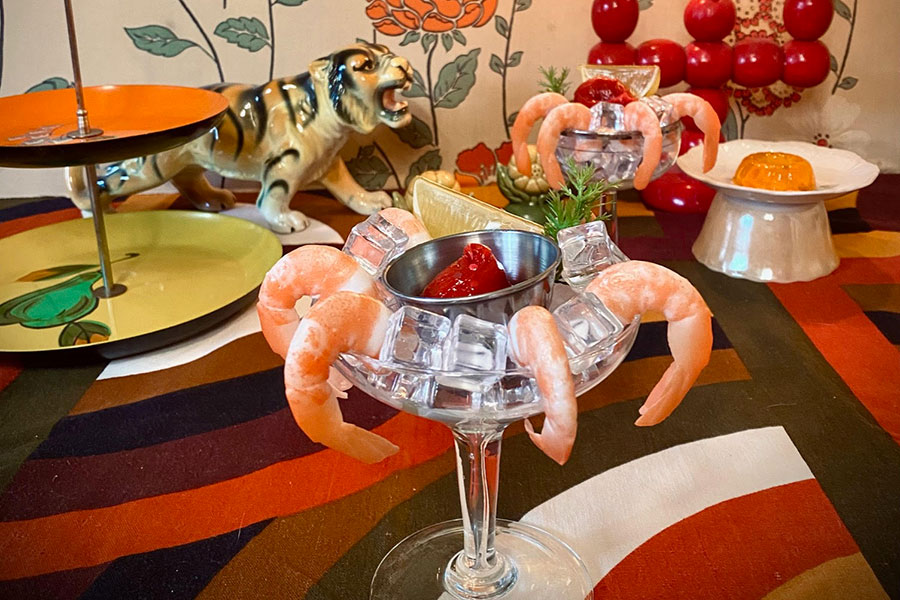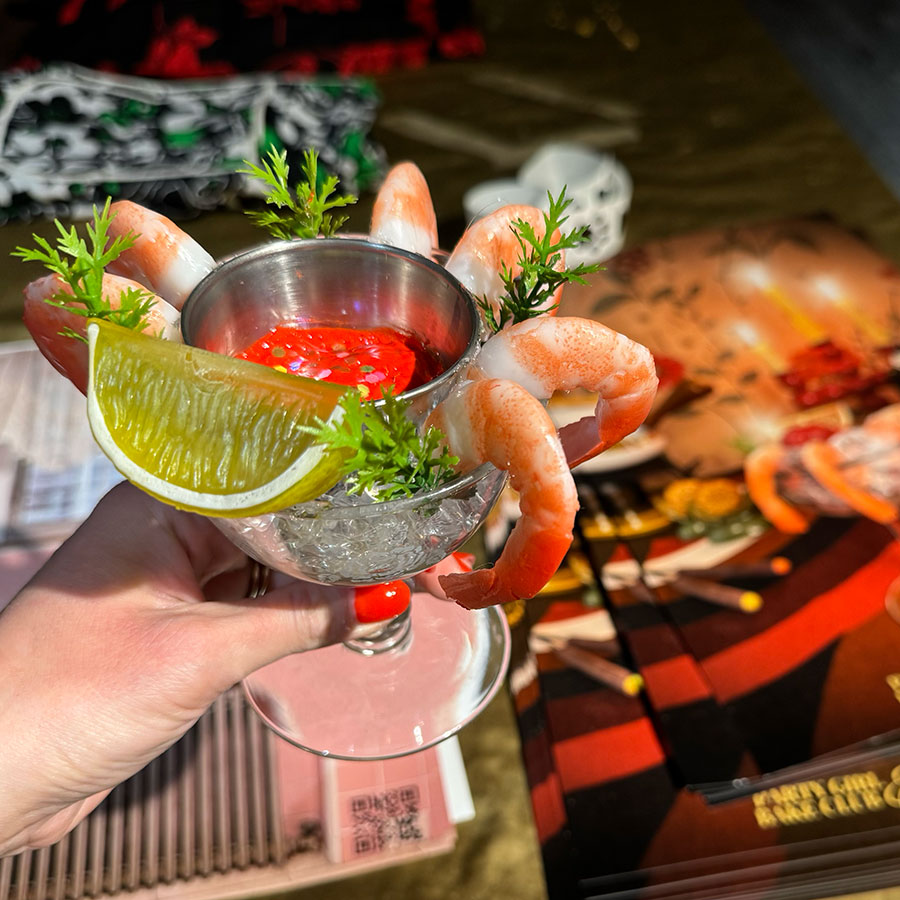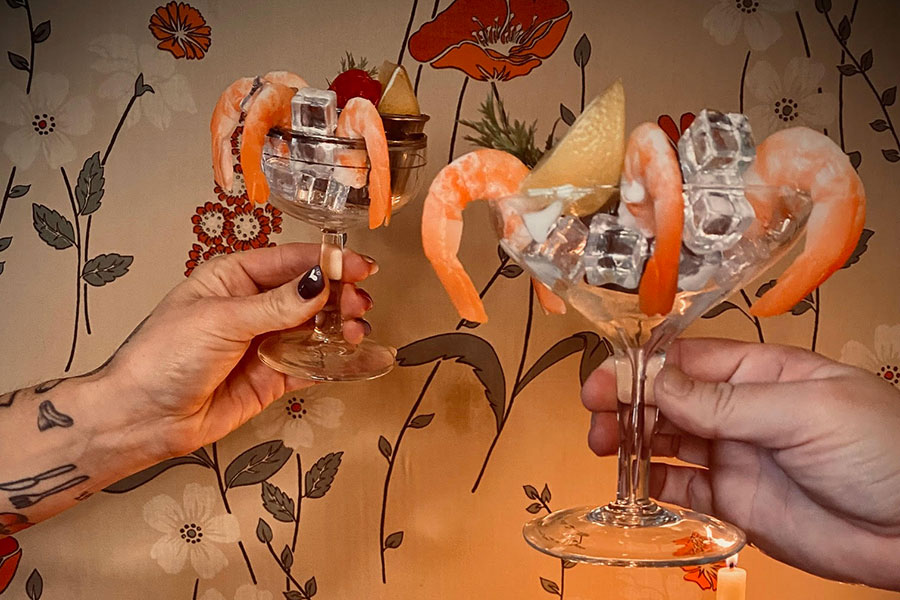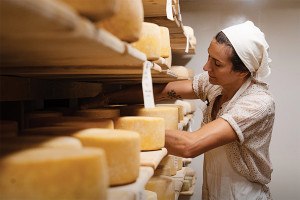What the Hell Is Going on With This Fake Shrimp Trend?
From faux shrimp cocktail workshops to shellfish-themed merch, the quirky crustacean is enjoying a kind of cultural renaissance in Philly.

Guests who attend Mallory Valvano and Sue Liedke’s “Faux Shrimp, Real Fun” get to take home their fake shrimp cocktail creations. / Photograph courtesy of Mallory Valvano and Sue Liedke
“Would you like some glitter in your cocktail sauce?”
It’s a question I’m not prepared to answer, but at the “Faux Shrimp, Real Fun” workshop, it’s par for the course. I’m spending a Friday night at Fleisher Art Memorial, attempting to make a visually appealing and entirely inedible shrimp cocktail out of PVC at the event, hosted by Mallory Valvano of Party Girl Bake Club and Sue Liedke, who runs the retro real estate Instagram account South Philly Time Capsules.
The workshop is part of a growing trend of fake food art. “Shokuhin sampuru,” as it’s called in Japan, where the art form started, refers to hyper-realistic food models often made of plastic or wax. About a century ago, before written menus were commonplace, displaying enticing plastic bowls of ramen (complete with fake, glistening broth) and anatomically correct replicas of nigiri was a popular way for restaurants in Japan to market themselves. But in recent years, shokuhin sampuru has captured the imaginations of American crafters and collectors who enjoy the art of completely inedible yet strangely appetizing faux foods — shrimp, in particular, seem to have attracted a cult-like following.
Case in point: tickets for the “Faux Shrimp, Real Fun” event sold out quickly, prompting Valvano and Liedke to open up another seating time for the workshop to accommodate those on the waitlist. The two are also hosting a shrimp cocktail candle workshop at Sunday Girl on September 14. While the workshop is part of an entire series of faux-food classes focused on retro food (the next one, on June 14, will take on fake sundaes and banana splits), it’s clear that shrimp is the star of the night.
As I adhere a fake crustacean to the rim of a vintage coupe glass, I consider Valvano’s question for a moment; I decide that, yes, I would love some glitter. It completes the stylized vibe I’m going for with my shrimp cocktail and even earns me a few compliments from other participants. As we get chatting, a couple seated at my table tells me they put up a “shrimpmas tree” over the holidays, and one of the pair says he has a standing bet with a friend that he can eat 50 Costco shrimp in five minutes. Later, when I join a line to pose for a picture in a photo booth that looks like a South Philly Time Capsules post come to life, I compliment an attendee’s necklace adorned with shrimp cocktail charms, and I notice someone else dressed head-to-toe in prawn pink. For some, shrimp is a lifestyle.

Photograph by Chloé Pantazi-Wolber
Liz Grothe, chef and owner of Scampi, is a self-described “shrimp observer and ultra fan” who often cooks with the crustacean, serving up the seafood in shrimp cocktails, fried on its own, or tucked into parcels of handmade pasta. While it’s not in everything she makes, shrimp unsurprisingly features prominently on Scampi’s website and Instagram, where it’s an unofficial mascot for Grothe’s dinner party-style cuisine that’s largely informed by her travels in Italy.
But Grothe’s love of the shellfish began in Oklahoma, where she grew up. “One of my early food memories was of peeling shrimp that my mom would buy in the Gulf of Mexico,” she says. “My parents would drive us down to the Gulf. They would buy a bunch of fresh shrimp, and then we would drive home as fast as we could.” Later, when Grothe started cooking professionally, she became “obsessed with it because it was something that was so classy and silly,” she says, adding that she considered it “the finest of dining.” The internet also amplified Grothe’s interest in shrimp as an adult. “‘Shrimps is bugs’ really got me,” the chef says, referencing the phrase that became an instant meme when a man shared a photo of his tattoo on Reddit, asking what he should cover it with (naturally, the internet told him not to).
Obviously, shrimp has been around a lot longer than the internet — it’s been widely available in the U.S. since the rise of refrigeration during the mid-20th century — but there’s no denying that it’s enjoying a kind of cultural renaissance right now. “Shrimp culture is evolving beside us,” Grothe says, speaking to the seafood’s broader appeal, which she attributes in part to the ubiquity of food in mainstream fashion. “Food is a flex,” Grothe says, before referencing a popular Rachel Antonoff pasta puffer coat that it seemed everyone was wearing in 2023. Perhaps it’s no coincidence that the same designer sells a seafood tower dress. But that’s just one item in a sea of shrimp-centric merch; these days, there’s a whole market for the shellfish in the fashion world, from high-end jewelry to hair accessories. It’s gotten so out of hand that in 2024, Bon Appétit ran an article headlined, “We’ve Finally Reached Peak Shrimp,” and New York Magazine declared the summer of that year “shrimp girl summer.” Even Saturday Night Live hopped on the shrimp bandwagon with their Shrimp Tower sketch, where Josh Brolin’s character goes to extraordinary lengths to protect his prized tower at a lavish party.

Photograph courtesy of Mallory Valvano and Sue Liedke
Our collective interest in shrimp could also be a sign of the times. Nostalgic foods are making a comeback nationwide in what’s been deemed the LOLfood trend. “Visually, the color and shape of shrimp are just intriguing,” Liedke says when I ask why she’s interested in the crustacean. “But more than that, for me, it’s about the nostalgia,” she adds. The South Philly Time Capsules creator associates shrimp with special occasions, travel, and “memorable moments in life,” and says it reminds her of the parties her grandparents threw. It also happens to fit the vintage aesthetic of Liedke’s popular Instagram account, as well as her personal style.
Similarly, Valvano is drawn to the shellfish as a celebration food — and if there’s a shrimp cocktail on a restaurant’s menu, she’s ordering it. “It’s kitschy but also very elegant. It’s like a go-to party trick,” the baker says of the dish. And she appreciates that it’s a luxury that can cost a little or a lot. “You could go to Acme and get a shrimp cocktail,” she says. “Or you could go to a really fancy restaurant and spend $36 for two to three shrimp in New York.”
Shrimp culture may never reach its boiling point, but still, what’s the harm in riding the wave while it lasts? At the end of the day, it’s just shrimp.


